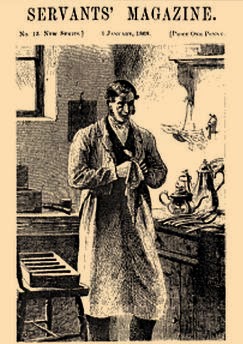 |
| From 1868 Servants' Magazine… The Butler Polishes the Silver |
Butlers
The word "butler" comes from Anglo-Norman "buteler," a version of the Old French "botellier" (officer in charge of the king's wine bottles) derived of "boteille" (bottle), Modern French "bouteille," itself from Gallo-Romance "buticula" (bottle).
 |
| Carson the butler on Downton Abbey keeps count of the wine |
The role of the butler, for centuries, has been that of the chief steward of a household, the attendant entrusted with the care and serving of wine and other bottled beverages which in ancient times might have represented a considerable portion of the household's assets.
Introduction to the Butler Stick Use
The Butler Stick has long been used in the Royal Palaces and the great estates of wealthy around the world. The Butler Stick is one of the secret tools of the highly trained professional that allows them to accurately set the table. Remember accuracy helps define the mediocre from the truly professional Butler. So how does one use a Butler Stick correctly? Below are a few simple tips to guide you through the process.
 |
| "He places the silver and plated articles on the table, sees that everything is in its place, and rectifies what is wrong..." |
The 24” Rule
This is one of the first rules you will be applying when preparing to set a formal table. The 24” rule refers to the ideal amount of space required from the centre of one plate to the centre of the other plate, which will allow the guest plenty of elbowroom. The picture below illustrates my point. Remember this distance of 24” is considered the ideal spacing. Often you may need to decrease the distance because the table is not large enough.
For two adjacent place settings, 24” between the centre of one plate to the centre of the other plate. Note: In metric the conversion of 24 inches is approximately 60
centimetres.
Calibrating the Individual Place Setting with a Butler Stick
There are a few guidelines when it comes to preparing an individual place setting. These guidelines will make the overall process of table setting both accurate and easy. These guidelines for calculating individual place settings apply to all western style place settings, that is North American, European, formal or informal.
Step 1: The base line for the place setting should always be +/- 1” from the edge of the table. The width of the Butler Stick is the ideal tool for this measurement. Align the Butler Stick at the edge of the table.Step 2: The top of the Butler Stick becomes the base line for the place setting. Base line created by the top of stick.Step 3: The measurement between the charger and the first knife will determine the spacing between all of the elements of the place setting.Step 4: Using the measurement between the charger and the first knife, apply this exact measurement to all of the points.
Symmetry Of The Individual Place Setting
Symmetry of the Formal Table
The symmetry of the entire table is as important as the symmetry of the individual place setting. Again, the attention to detail sets the difference between a professional Butler and an amateur.
 |
| "When you think of the scale of very large dining tables with 12, 25 or even 75 guests per side, the string and the Butler Stick are very handy tools to setting a symmetrical table." |
The two handy tools that you will need to be successful in achieving symmetry, particularly on large dining tables are a Butler Stick and a long piece of string. The Butler Stick will enable you to take measurements so the spacing of all elements on the table will be exact. The piece of string that is secured at both ends of the table is an ideal way to create a level base line for your place settings.
| Special thanks to Charles Mac Pherson Associates for allowing Etiquipedia to reprint the information on the Butler Stick. |
🍽️Etiquette Enthusiast, Maura J. Graber of The RSVP Institute of Etiquette, is the Site Editor of the Etiquipedia© Etiquette Encyclopedia


No comments:
Post a Comment
Note: Only a member of this blog may post a comment.